苏教版小学六年级英语毕业复习资料(全)
- 格式:pdf
- 大小:70.98 KB
- 文档页数:9
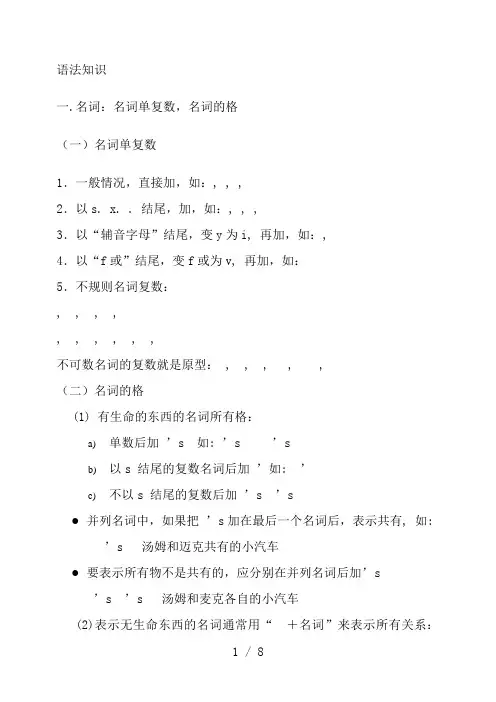
语法知识一.名词:名词单复数,名词的格(一)名词单复数1.一般情况,直接加,如:, , ,2.以s. x. . 结尾,加,如:, , ,3.以“辅音字母”结尾,变y为i, 再加,如:,4.以“f或”结尾,变f或为v, 再加,如:5.不规则名词复数:, , , ,, , , , , ,不可数名词的复数就是原型: , , , , ,(二)名词的格(1) 有生命的东西的名词所有格:a)单数后加’s 如: ’s ’sb)以s 结尾的复数名词后加’如: ’c)不以s 结尾的复数后加’s ’s●并列名词中,如果把’s加在最后一个名词后,表示共有, 如:’s 汤姆和迈克共有的小汽车●要表示所有物不是共有的,应分别在并列名词后加’s’s ’s 汤姆和麦克各自的小汽车(2)表示无生命东西的名词通常用“ +名词”来表示所有关系:如:a a二.冠词:不定冠词,定冠词种类:(1)不定冠词:a / a /元音开头的可数名词前用 :/ / / / / / / / / / / / / / / / / / /(2)定冠词:2. 用法:定冠词的用法:(1)特指某(些)人或某(些)物: .(2)复述上文提到的人或物: a . .(3)谈话双方都知道的人或物:’t .(4)在序数词前:’s .(5)用于固定词组中: / /不用冠词的情况:(1)专有名词前: a .(2)名词前有定语: , , , , , , 等:.(3)复数名词表示一类人和事:’t . .(4)在节日,日期,月份,季节前:. ’s .(5)一日三餐前: 6:30.(6)球类棋类运动前: . .* 但乐器前要用定冠词:I .(7)学科名称前: .(8)在称呼或头衔的名词前: .(9)固定词组中:三、代词:人称代词,物主代词四、形容词,副词:比较级,最高级(一)、形容词的比较级1、形容词比较级在句子中的运用:两个事物或人的比较用比较级,比较级后面一般带有单词。
比较级前面可以用, a 来修饰表示程度。
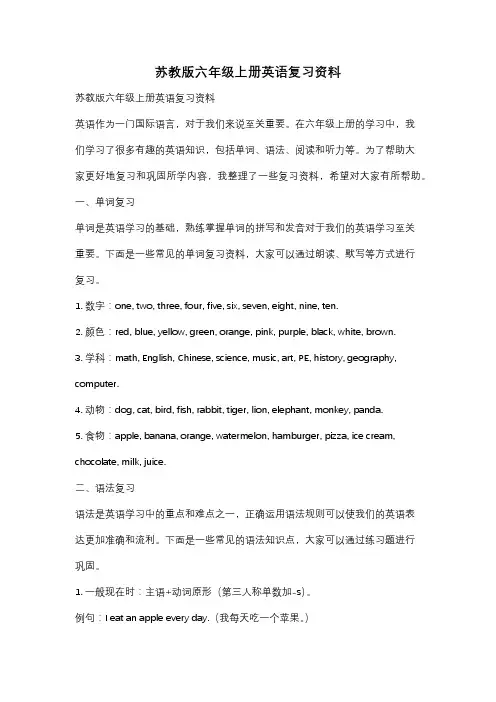
苏教版六年级上册英语复习资料苏教版六年级上册英语复习资料英语作为一门国际语言,对于我们来说至关重要。
在六年级上册的学习中,我们学习了很多有趣的英语知识,包括单词、语法、阅读和听力等。
为了帮助大家更好地复习和巩固所学内容,我整理了一些复习资料,希望对大家有所帮助。
一、单词复习单词是英语学习的基础,熟练掌握单词的拼写和发音对于我们的英语学习至关重要。
下面是一些常见的单词复习资料,大家可以通过朗读、默写等方式进行复习。
1. 数字:one, two, three, four, five, six, seven, eight, nine, ten.2. 颜色:red, blue, yellow, green, orange, pink, purple, black, white, brown.3. 学科:math, English, Chinese, science, music, art, PE, history, geography, computer.4. 动物:dog, cat, bird, fish, rabbit, tiger, lion, elephant, monkey, panda.5. 食物:apple, banana, orange, watermelon, hamburger, pizza, ice cream, chocolate, milk, juice.二、语法复习语法是英语学习中的重点和难点之一,正确运用语法规则可以使我们的英语表达更加准确和流利。
下面是一些常见的语法知识点,大家可以通过练习题进行巩固。
1. 一般现在时:主语+动词原形(第三人称单数加-s)。
例句:I eat an apple every day.(我每天吃一个苹果。
)2. 一般过去时:主语+动词过去式。
例句:He watched a movie last night.(他昨晚看了一部电影。
)3. 现在进行时:主语+be动词(am/is/are)+动词-ing。
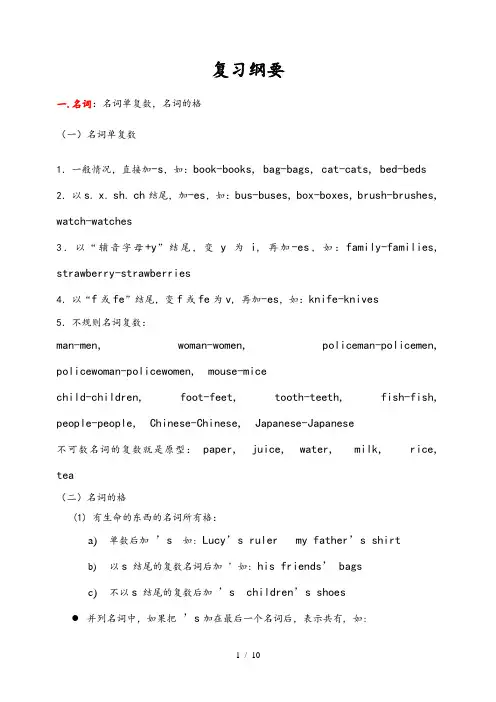
复习纲要一.名词:名词单复数,名词的格(一)名词单复数1.一般情况,直接加-s,如:book-books, bag-bags, cat-cats, bed-beds 2.以s. x. sh. ch结尾,加-es,如:bus-buses, box-boxes, brush-brushes, watch-watches3.以“辅音字母+y”结尾,变y为i, 再加-es,如:family-families, strawberry-strawberries4.以“f或fe”结尾,变f或fe为v, 再加-es,如:knife-knives5.不规则名词复数:man-men, woman-women, policeman-policemen, policewoman-policewomen, mouse-micechild-children, foot-feet, tooth-teeth, fish-fish, people-people, Chinese-Chinese, Japanese-Japanese不可数名词的复数就是原型: paper, juice, water, milk, rice, tea(二)名词的格(1) 有生命的东西的名词所有格:a)单数后加’s如: Lucy’s ruler my father’s shirtb)以s结尾的复数名词后加’如: his friends’ bagsc)不以s结尾的复数后加’s children’s shoes并列名词中,如果把’s加在最后一个名词后,表示共有, 如:Tom and Mike’s car汤姆和迈克共有的小汽车要表示所有物不是共有的,应分别在并列名词后加’sTom’s and Mike’s cars 汤姆和麦克各自的小汽车(2)表示无生命东西的名词通常用“ of+名词”来表示所有关系:如:Apictureoftheclassroom a map of China二.冠词:不定冠词,定冠词种类:(1)不定冠词:a / an a unit / an uncle元音开头的可数名词前用an :an egg / an apple / an orange / an eraser / an answer / an ID card / an alarm clock / an actor / an actress / an / an address / an event / an example / an opera / an old man / an interesting book / an exciting sport / an action movie / an art lesson /(2)定冠词:the the egg the plane2. 用法:定冠词的用法:(1)特指某(些)人或某(些)物:The ruler is on the desk.(2)复述上文提到的人或物:He has a sweater. The sweater is new. (3)谈话双方都知道的人或物:The boys aren’t at school.(4)在序数词前:John’s birthday is February the second.(5)用于固定词组中: in the morning / afternoon / evening不用冠词的情况:(1)专有名词前:China is a big country.(2)名词前有定语:this , that , my , your , some, any , no 等:This is my baseball.(3)复数名词表示一类人和事:Monkeys can’t swim. They are teachers.(4)在节日,日期,月份,季节前:Today is Christmas Day. It’s Sunday.(5)一日三餐前:We have breakfast at 6:30.(6)球类棋类运动前:They often play football after class. He plays chess at home.* 但乐器前要用定冠词:I play the guitar very well.(7)学科名称前:My favorite subject is music.(8)在称呼或头衔的名词前:This is Mr. Li.(9)固定词组中:at noon at night by bus三、代词:人称代词,物主代词四、形容词,副词:比较级,最高级(一)、形容词的比较级1、形容词比较级在句子中的运用:两个事物或人的比较用比较级,比较级后面一般带有单词than。
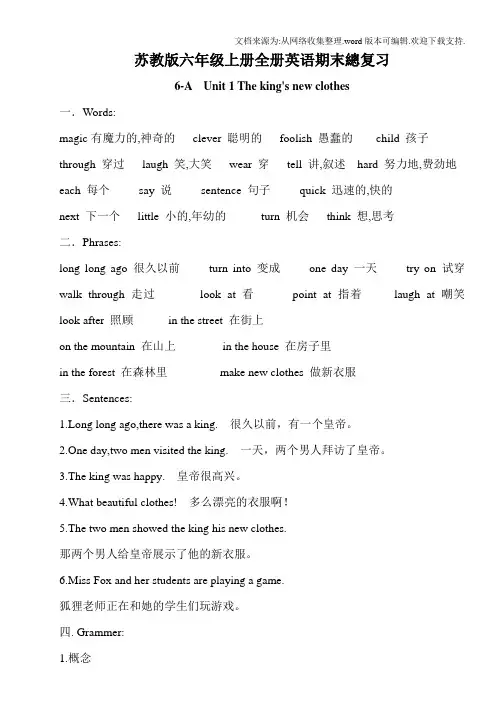
苏教版六年级上册全册英语期末總复习6-A Unit 1 The king's new clothes一.Words:magic有魔力的,神奇的clever 聪明的foolish 愚蠢的child 孩子through 穿过laugh 笑,大笑wear 穿tell 讲,叙述hard 努力地,费劲地each 每个say 说sentence 句子quick 迅速的,快的next 下一个little 小的,年幼的turn 机会think 想,思考二.Phrases:long long ago 很久以前turn into 变成one day 一天try on 试穿walk through 走过look at 看point at 指着laugh at 嘲笑look after 照顾in the street 在街上on the mountain 在山上in the house 在房子里in the forest 在森林里make new clothes 做新衣服三.Sentences:1.Long long ago,there was a king. 很久以前,有一个皇帝。
2.One day,two men visited the king. 一天,两个男人拜访了皇帝。
3.The king was happy. 皇帝很高兴。
4.What beautiful clothes! 多么漂亮的衣服啊!5.The two men showed the king his new clothes.那两个男人给皇帝展示了他的新衣服。
6.Miss Fox and her students are playing a game.狐狸老师正在和她的学生们玩游戏。
四. Grammer:1.概念在过去某个时间里发生的动作或存在的状态:过去习惯性或经常性的动作、行为。
2.时间状语ago,yesterday,the day before yesterday,last week(year,night,month…),in 1989,just now,long long ago,once upon a time.3.肯定句主语+行为动词(过去式)+其他。
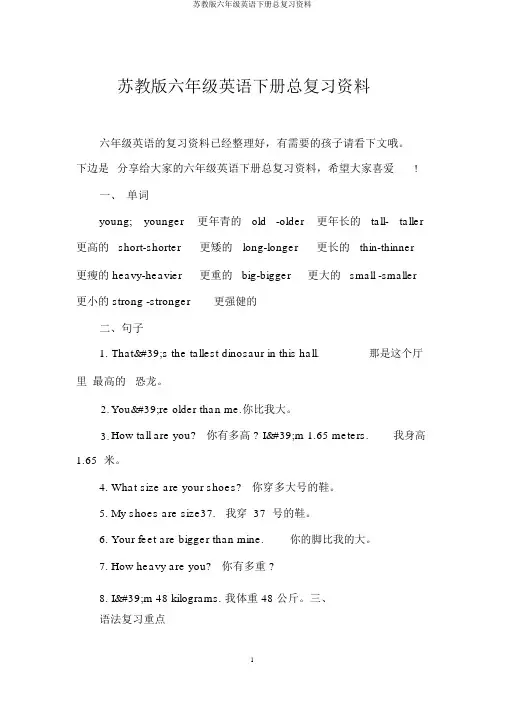
苏教版六年级英语下册总复习资料六年级英语的复习资料已经整理好,有需要的孩子请看下文哦。
下边是分享给大家的六年级英语下册总复习资料,希望大家喜爱!一、单词young; younger更年青的old -older更年长的tall- taller 更高的short-shorter更矮的long-longer更长的thin-thinner 更瘦的 heavy-heavier更重的big-bigger更大的small -smaller 更小的 strong -stronger更强健的二、句子1. That's the tallest dinosaur in this hall.那是这个厅里最高的恐龙。
2.You're older than me.你比我大。
3.How tall are you? 你有多高 ? I'm 1.65 meters.我身高1.65 米。
4.What size are your shoes? 你穿多大号的鞋。
5.My shoes are size37. 我穿 37 号的鞋。
6. Your feet are bigger than mine.你的脚比我的大。
7.How heavy are you? 你有多重 ?8.I'm 48 kilograms. 我体重 48 公斤。
三、语法复习重点形容词的比较级1、形容词比较级在句子中的运用:两个事物或人的比较用比较级,比较级后边一般带有单词than 。
than 后的人称代词用主格(口语中可用宾格)。
2.形容词加 er 的规则:⑴一般在词尾加er ;⑵以字母 e 结尾,加r ;nice---nicer⑶以一个元音字母和一个辅音字母结尾,应双写末端的辅音字母,再加er ;big--- bigger thin---- thinner⑷以“辅音字母 +y ”结尾,先把y变i ,再加er。
heavy----heavier3. 不规则形容词比较级:good/well-better 21;世纪*教育网例句: (1).It's taller than both of us together.它比我俩加起来还高。
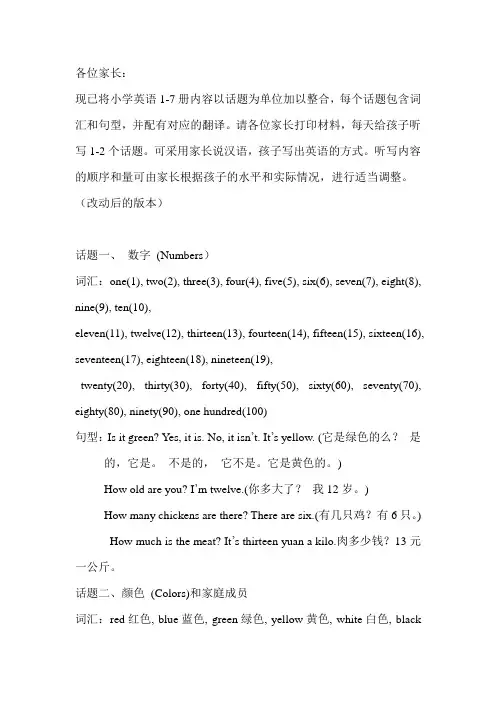
各位家长:现已将小学英语1-7册内容以话题为单位加以整合,每个话题包含词汇和句型,并配有对应的翻译。
请各位家长打印材料,每天给孩子听写1-2个话题。
可采用家长说汉语,孩子写出英语的方式。
听写内容的顺序和量可由家长根据孩子的水平和实际情况,进行适当调整。
(改动后的版本)话题一、数字(Numbers)词汇:one(1), two(2), three(3), four(4), five(5), six(6), seven(7), eight(8), nine(9), ten(10),eleven(11), twelve(12), thirteen(13), fourteen(14), fifteen(15), sixteen(16), seventeen(17), eighteen(18), nineteen(19),twenty(20), thirty(30), forty(40), fifty(50), sixty(60), seventy(70), eighty(80), ninety(90), one hundred(100)句型:Is it green? Yes, it is. No, it isn’t. It’s yellow. (它是绿色的么?是的,它是。
不是的,它不是。
它是黄色的。
)How old are you? I’m twelve.(你多大了?我12岁。
)How many chickens are there? There are six.(有几只鸡?有6只。
)How much is the meat? It’s thirteen yuan a kilo.肉多少钱?13元一公斤。
话题二、颜色(Colors)和家庭成员词汇:red红色, blue蓝色, green绿色, yellow黄色, white白色, black黑色, brown棕色, purple紫色, pink粉红, orange橙色, grey灰色句型:What’s this? It’s a green book.这是什么?是一本绿色的书。
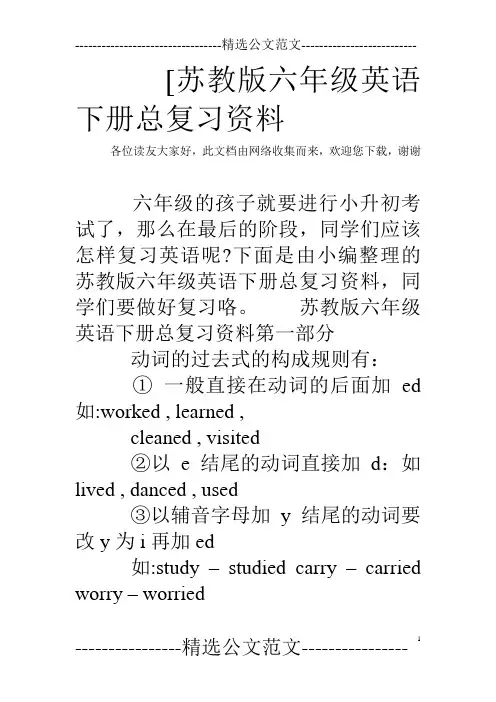
[苏教版六年级英语下册总复习资料各位读友大家好,此文档由网络收集而来,欢迎您下载,谢谢六年级的孩子就要进行小升初考试了,那么在最后的阶段,同学们应该怎样复习英语呢?下面是由小编整理的苏教版六年级英语下册总复习资料,同学们要做好复习咯。
苏教版六年级英语下册总复习资料第一部分动词的过去式的构成规则有:①一般直接在动词的后面加ed 如:worked , learned ,cleaned , visited②以e结尾的动词直接加d:如lived , danced , used③以辅音字母加y结尾的动词要改y为i再加ed如:study –studied carry –carried worry – worried④双写最后一个字母如:stopped动词的ing形式的构成规则:①一般的直接在后面加上ing ,如:doing , going , working , singing , eating②以e 结尾的动词,要先去e再加ing ,如:having , writing③双写最后一个字母的如:running , swimming , sitting , getting苏教版六年级英语下册总复习资料第二部分句型专项归类:1、肯定句:是指用肯定的语气来陈述的句子,如:I’m a student. She is a doctor. He works in a hospital.There are four fans in our classroom.He will eat lunch at 12:00.I watched TV yesterday evening.2、一般疑问句:必须用“yes”,或“no”来回答。
•Are you a student? Yes, I am / No, I’m not.•Is she a doctor? Yes, she is. / No, she isn’t.•Does he work in a hospital? Yes, he does. / No, he doesn’t.•Are there four fans in our classroom? Yes, there are. / No, there aren’t.•Are you going to buy a comic book tonight? Yes, I am. / No, I am not.•Will he eat lunch at 12:00? Yes, I will. / No, I will not.•Are they swimming? Yes, they are. / No, they aren’t.•Did you watch TV yester day evening? Yes, I did. / No, I didn’t.3、特殊疑问句:以特殊疑问词开头引导的句子. 此类句子应该问什么就答什么,不能用“yes 、no”来回答。
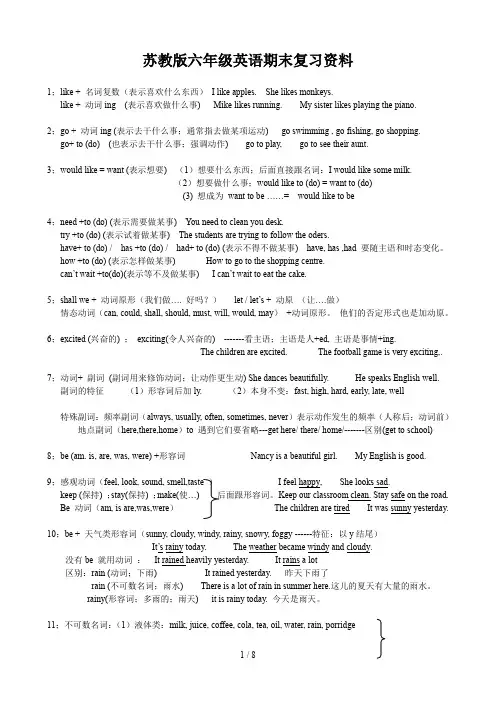
苏教版六年级英语期末复习资料1;like + 名词复数(表示喜欢什么东西)I like apples. She likes monkeys.like + 动词ing (表示喜欢做什么事) Mike likes running. My sister likes playing the piano.2;go + 动词ing (表示去干什么事;通常指去做某项运动) go swimming , go fishing, go shopping.go+ to (do) (也表示去干什么事;强调动作) go to play, go to see their aunt.3;would like = want (表示想要) (1)想要什么东西;后面直接跟名词:I would like some milk.(2)想要做什么事;would like to (do) = want to (do)(3) 想成为want to be ……= would like to be4;need +to (do) (表示需要做某事) You need to clean you desk.try +to (do) (表示试着做某事) The students are trying to follow the oders.have+ to (do) / has +to (do) / had+ to (do) (表示不得不做某事) have, has ,had 要随主语和时态变化。
how +to (do) (表示怎样做某事) How to go to the shopping centre.can’t wait +to(do)(表示等不及做某事) I can’t wait to eat the cake.5;shall we + 动词原形(我们做…. 好吗?)let / let’s + 动原(让….做)情态动词(can, could, shall, should, must, will, would, may)+动词原形。
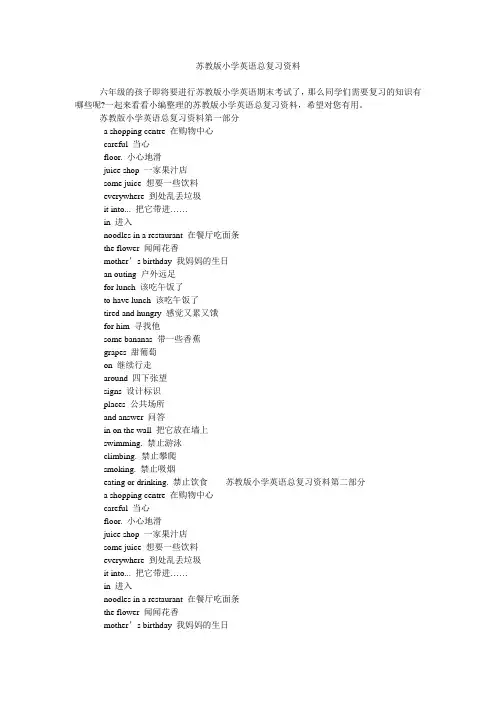
苏教版小学英语总复习资料六年级的孩子即将要进行苏教版小学英语期末考试了,那么同学们需要复习的知识有哪些呢?一起来看看小编整理的苏教版小学英语总复习资料,希望对您有用。
苏教版小学英语总复习资料第一部分a shopping centre 在购物中心careful 当心floor. 小心地滑juice shop 一家果汁店some juice 想要一些饮料everywhere 到处乱丢垃圾it into... 把它带进……in 进入noodles in a restaurant 在餐厅吃面条the flower 闻闻花香mother’s birthday 我妈妈的生日an outing 户外远足for lunch 该吃午饭了to have lunch 该吃午饭了tired and hungry 感觉又累又饿for him 寻找他some bananas 带一些香蕉grapes 甜葡萄on 继续行走around 四下张望signs 设计标识places 公共场所and answer 问答in on the wall 把它放在墙上swimming. 禁止游泳climbing. 禁止攀爬smoking. 禁止吸烟eating or drinking. 禁止饮食苏教版小学英语总复习资料第二部分a shopping centre 在购物中心careful 当心floor. 小心地滑juice shop 一家果汁店some juice 想要一些饮料everywhere 到处乱丢垃圾it into... 把它带进……in 进入noodles in a restaurant 在餐厅吃面条the flower 闻闻花香mother’s birthday 我妈妈的生日an outing 户外远足for lunch 该吃午饭了to have lunch 该吃午饭了tired and hungry 感觉又累又饿for him 寻找他some bananas 带一些香蕉grapes 甜葡萄on 继续行走around 四下张望signs 设计标识places 公共场所and answer 问答in on the wall 把它放在墙上swimming. 禁止游泳climbing. 禁止攀爬smoking. 禁止吸烟eating or drinking. 禁止饮食。
复习纲要一、名词:名词单复数,名词的格(一)名词单复数1.一般情况,直接加-s,如:book-books, bag-bags, cat-cats, bed-beds2.以s、 x、 sh、 ch结尾,加-es,如:bus-buses, box-boxes, brush-brushes, watch-watches3.以“辅音字母+y”结尾,变y为i, 再加-es,如:family-families, strawberry-strawberries4.以“f或fe”结尾,变f或fe为v, 再加-es,如:knife-knives5.不规则名词复数:man-men, woman-women, policeman-policemen, policewoman-policewomen, mouse-micechild-children, foot-feet, tooth-teeth, fish-fish, people-people, Chinese-Chinese, Japanese-Japanese不可数名词的复数就就是原型: paper, juice, water, milk, rice,tea(二)名词的格(1) 有生命的东西的名词所有格:a)单数后加’s如: Lucy’s ruler my father’s shirtb)以s结尾的复数名词后加’如: his friends’ bagsc)不以s结尾的复数后加’s children’s shoes并列名词中,如果把’s加在最后一个名词后,表示共有, 如:Tom and Mike’s car汤姆与迈克共有的小汽车要表示所有物不就是共有的,应分别在并列名词后加’sTom’s and Mike’s cars 汤姆与麦克各自的小汽车(2)表示无生命东西的名词通常用“ of+名词”来表示所有关系:如:A picture of the classroom a map of China二、冠词:不定冠词,定冠词种类:(1)不定冠词:a / an a unit / an uncle元音开头的可数名词前用an :an egg / an apple / an orange / an eraser / an answer / an ID card/ an alarm clock / an actor / an actress / an e-mail / an address /an event / an example / an opera / an old man / an interesting book/ an exciting sport / an action movie / an art lesson /(2)定冠词:the the egg the plane2、用法:定冠词的用法:(1)特指某(些)人或某(些)物: The ruler is on the desk、(2)复述上文提到的人或物:He has a sweater、 The sweater is new、(3)谈话双方都知道的人或物:The boys aren’t at school、(4)在序数词前:John’s birthday is February the second、(5)用于固定词组中: in the morning / afternoon / evening不用冠词的情况:(1)专有名词前:China is a big country、(2)名词前有定语:this , that , my , your , some, any , no 等:This is my baseball、(3)复数名词表示一类人与事:Monkeys can’t swim、 They are teachers、(4)在节日,日期,月份,季节前:Today is Christmas Day、It’s Sunday、(5)一日三餐前:We have breakfast at 6:30、(6)球类棋类运动前:They often play football after class、 He plays chess at home、* 但乐器前要用定冠词:I play the guitar very well、(7)学科名称前:My favorite subject is music、(8)在称呼或头衔的名词前:This is Mr、 Li、(9)固定词组中:at noon at night by bus三、代词:人称代词,物主代词人称代词物主代词主格宾格第一人称单数I(我) me my(我的) 复数we(我们) us our(我们的)第二人称单数you(您) you your(您的) 复数you(您们) you your(您们的)第三人称单数he(她) him his(她的)she(她) her her(她的)it(它) it its(它的)their(她们的/她们的/它复数they(她们/她们/它们) them们的)四、形容词,副词:比较级,最高级(一)、形容词的比较级1、形容词比较级在句子中的运用:两个事物或人的比较用比较级,比较级后面一般带有单词than。
比较级前面可以用more, a little来修饰表示程度。
than后的人称代词用主格(口语中可用宾格)。
2.形容词加er的规则:⑴一般在词尾加er ;⑵以字母e结尾,加r ;⑶以一个元音字母与一个辅音字母结尾,应双写末尾的辅音字母,再加er ;⑷以“辅音字母+y”结尾,先把y变i,再加er 。
3.不规则形容词比较级:good-better, beautiful-more beautiful(二)副词的比较级1.形容词与副词的区别 (有be用形,有形用be;有动用副,有副用动)⑴在句子中形容词一般处于名词之前或be动词之后⑵副词在句子中最常见的就是处于实义动词之后2.副词比较级的变化规则基本与形容词比较级相同 (不规则变化:well-better, far-farther)五数词:基数词,序数词(1)1-20one,two,three,four,five,six,seven,eight,nine,ten,eleven,twelve,thirteen,fourteen,fifteen,sixteen,seventeen,eighteen,nineteen,twenty(2)21-99 先说“几十”,再说“几”,中间加连字符。
23→twenty-three,34→thirty-four,45→forty—five,56→fifty-six ,67→sixty-seven,78→seventy-eight,89→eighty-nine,91→ninety-one (3)101—999先说“几百”,再加and,再加末两位数或末位数;586→five hundred and eighty-six,803→eight hundred and three (4)l,000以上,先从右往左数,每三位数加一个“,”,第一个“,”前为thousand、第二个“,”前为million,第三个“,”前为billion1,001→one thousand and one18,423→eighteen thousand,four hundred and twenty-three6,260,309→six million two hundred and sixty thousand three hundred and nine750,000,000,000→seven hundred and fifty billion二、序数词(1)一般在基数词后加theg、four→fourth,thirteen→thirteenth(2)不规则变化one→first,two→second,three→third,five→fifth,eight→eighth, nine→ninth,twelve—twelfth(3)以y结尾的十位整数,变y为ie再加thtwenty→twentieth, forty→fortieth, ninety→ninetieth(4)从二十一后的“几十几”直至“几百几十几”或“几千几百几十几”只将个位的基数词变为序数词。
twenty-first,two hundred and forty-fifth基数词转为序数词的口诀:基变序,有规律,词尾加上-th。
一,二,三,特殊记,词尾字母t,d,d。
八去t,九去e, ve要用f替。
ty将y变成i,th前面有个e。
若就是碰到几十几,前用基来后用序。
六、介词:常用介词:in, on, at, behind等1、at表示时间概念的某一个点。
(在某时刻、时间、阶段等)。
at 1:00(dawn,midnight,noon)在一点钟(黎明、午夜、中午)2.on1)表示具体日期。
注:(1)关于"在周末"的几种表示法:at(on)the weekend在周末---特指at(on)weekends在周末---泛指over the weekend在整个周末during the weekend在周末期间(2)在圣诞节,应说at Christmas而不说on Christmas2)在(刚……)的时候。
On reaching the city he called up his parents.一到城里她就给父母打了一个电话。
3.in1)表示"时段"、"时期",在多数情况下可以与during互换,前者强调对比,后者强调持续。
in(during)1988(December,the 20th century)在一九八八年(十二月、二十世纪)七、动词:动词的四种时态:(1)一般现在时:一般现在时的构成1、 be动词:主语+be(am, is, are)+其它。
如: I am a boy、我就是一个男孩。
2、行为动词:主语+行为动词(+其它)。
如: We study English、我们学习英语。
当主语为第三人称单数(he, she, it)时,要在动词后加"-s"或"-es"。
如:Mary likes Chinese、玛丽喜欢汉语。
动词+s的变化规则1.一般情况下,直接加-s,如:cook-cooks, milk-milks2.以s、 x、 sh、 ch、 o结尾,加-es,如:guess-guesses, wash-washes, watch-watches, go-goes3.以“辅音字母+y”结尾,变y为i, 再加-es,如:study-studies(2)一般过去时:动词过去式详解动词的过去式的构成规则有:A、规则动词①一般直接在动词的后面加ed:如worked , learned , cleaned ,visited②以e结尾的动词直接加d:如lived , danced , used③以辅音字母加y结尾的动词要改y为i再加ed(此类动词较少)如study –studied carry – carried worry – worried (注意play、stay不就是辅音字母加y,所以不属于此类)④双写最后一个字母(此类动词较少)如stoppedB、不规则动词(此类词并无规则,须熟记)小学阶段要记住以下动词的原形与过去式:sing – sang , eat – ate ,see – saw , have – had , do – did , go – went , take – took , buy –bought , get –got , read –read ,fly –flew , am/is –was , are – were , say – said , leave – left , swim – swam , tell –told , draw – drew , come – came , lose – lost , find – found , drink – drank , hurt – hurt , feel – felt(3)一般将来时:基本结构: ①be going to + d o;②will+ do、 be going to = willI am going to go swimming tomorrow(明天)、 = I will go swimming tomorrow、(4)现在进行时: am,is,are+动词现在分词动词现在分词详解动词的ing形式的构成规则:①一般的直接在后面加上ing, 如doing , going , working , singing ,eating②以e结尾的动词,要先去e再加ing,如having , writing③双写最后一个字母的(此类动词极少)有:running , swimming , sitting ,getting需要熟记的小知识点1、a lot of 、lots of表示“许多”: +可数名词/不可数名词。